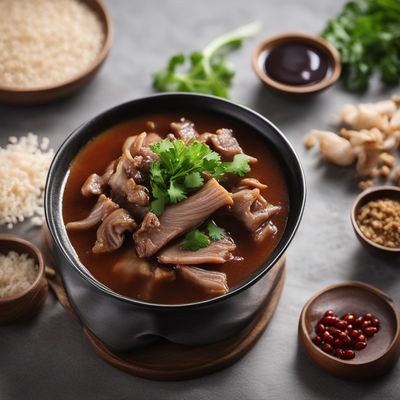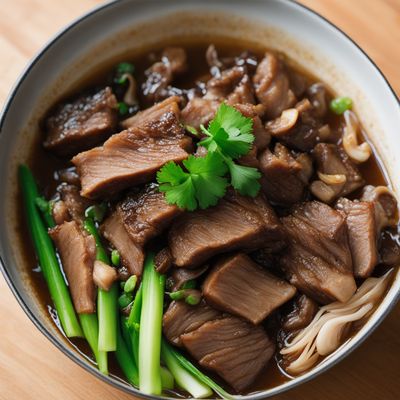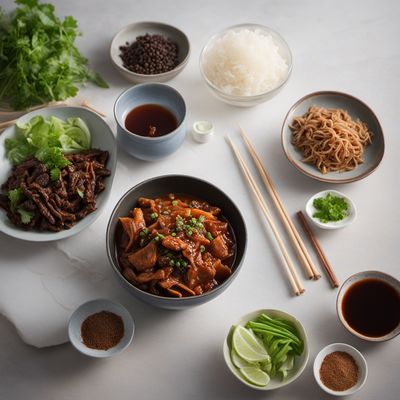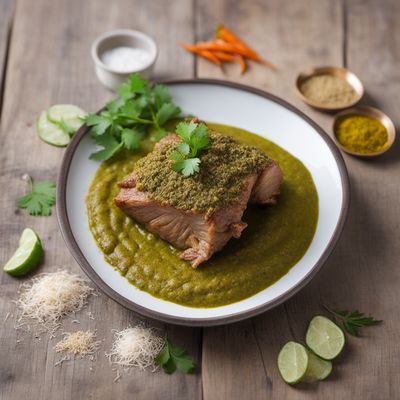
Ingredient
Pig stomach
The Savory Delicacy
Pig stomach has a chewy and slightly rubbery texture, with a mild flavor that absorbs the taste of the ingredients it is cooked with. It is pale in color and has a distinctive honeycomb-like pattern on its surface. When properly cleaned and prepared, pig stomach becomes tender and flavorful, making it a sought-after ingredient in many culinary traditions.
Origins and history
The consumption of pig stomach dates back centuries and is prevalent in many cultures around the world. It is particularly popular in Chinese, Korean, and European cuisines. In Chinese cuisine, pig stomach is often used in traditional soups and hot pot dishes. In Korean cuisine, it is a key ingredient in dishes like kimchi jjigae (kimchi stew). In European cuisine, pig stomach is used in dishes like tripe soup and stuffed tripe. Its popularity can be attributed to its unique texture and ability to absorb flavors.
Nutritional information
Pig stomach is a good source of protein, vitamins, and minerals. It is low in fat and calories, making it a nutritious choice for those looking to incorporate lean meats into their diet. A 3-ounce (85g) serving of pig stomach provides approximately 100 calories and 20 grams of protein.
Allergens
Pig stomach may cause allergic reactions in individuals with a sensitivity to pork or other meats. It is also not suitable for those following a vegetarian or vegan diet.
How to select
When selecting pig stomach, choose those that are fresh, firm, and free from any foul odor. Avoid stomachs that have a slimy or discolored appearance, as this may indicate spoilage. If purchasing from a butcher, ask for stomachs that have been thoroughly cleaned and prepared.
Storage recommendations
To maintain the freshness of pig stomach, it should be consumed as soon as possible after purchase. If not using immediately, store it in the refrigerator at a temperature below 40°F (4°C). It is best to wrap it tightly in plastic wrap or place it in an airtight container to prevent any odors from permeating other foods.
How to produce
Pig stomach is typically produced by professional butchers or meat processors. It requires specialized knowledge and equipment to properly clean and prepare the stomach for cooking. It is not recommended for amateur production at home.
Preparation tips
Before cooking pig stomach, it needs to be thoroughly cleaned and soaked in cold water to remove any impurities or residual odors. It can then be boiled, braised, or stir-fried to achieve the desired tenderness. Pig stomach is commonly used in soups, stews, and stir-fries, where it absorbs the flavors of the other ingredients and adds a unique texture to the dish.
Culinary uses
Pig stomach is commonly used in various cuisines around the world. In Chinese cuisine, it is used in soups, hot pot dishes, and stir-fries. In Korean cuisine, it is a key ingredient in kimchi stew. In European cuisine, it is used in dishes like tripe soup and stuffed tripe. It can also be pickled or marinated for added flavor.
Availability
Pig stomach is commonly available in butcher shops, Asian markets, and specialty grocery stores. It may be more challenging to find in mainstream supermarkets.
More ingredients from this category

Pig trotters and feet
"Savory Delights: Exploring the World of Pig Trotters and Feet"

Pig tongue
A Delicacy Worth Exploring

Pig heart
The Versatile Organ: Pig Heart

Pig head
The Versatile Delicacy: Pig Head

Pig marrowbone
"Savor the Richness: Exploring the Delights of Pig Marrowbone"

Pig tail
"Savor the Delightful Twist: Exploring the Culinary Wonders of Pig Tail"
Recipes using Pig stomach

Crispy Roasted Guinea Pig
Andean Delight: Crispy Roasted Guinea Pig with Peruvian Flair

Pig's Organ Soup
Savory Delight: Singaporean Pig's Organ Soup

Uter Adobo
Savory and Tangy Uter Adobo: A Filipino Delicacy

Omaha-style Motsunabe
Savory Offal Stew: A Taste of Omaha

Kostelski želodec with Herbed Potato Salad
Savory Stuffed Pork Stomach with Fragrant Herbed Potato Salad

Putian-style Roast Pork
Crispy and Flavorful Putian Roast Pork Delight

Homemade Kway Chap
Savory Delights: Homemade Kway Chap - A Singaporean Culinary Gem

Odia-style Stuffed Pork Stomach
Savory Delight: Odia-style Stuffed Pork Stomach

Hog Maw Delight
Savory Stuffed Hog Maw: A Delightful Twist on American Cuisine